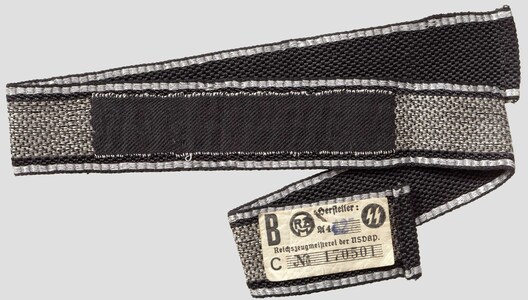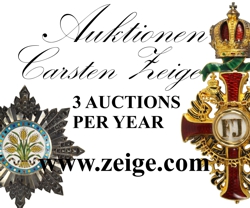SS-TV Thüringen Standarte Cuff Title
SKU: 50.GOR.04.03.03.01.001
Estimated market value:


Estimated market value:
Attributes
History
In March of 1933, the SS-Wachverbände (SS-Guard Units) were instituted to administer the concentration camps of the Third Reich. In 1936, the administrative and guard units of the SS-Wachverbände were re-designated as the SS-Totenkopfverbände.
In July of 1937, the five battalions of the SS-TV were re-organised into three regiments (Standarten). Due to the change, Officers were no longer permitted to wear collar tabs with battalion numbers. In 1938, a fourth regiment was added to the SS-TV.
The 3rd SS-Totenkopfstandarte "Thüringen" was formed by merging SS-Wachsturmbann (Guard Battalion) "Elbe" and SS-Wachsturmmbann "Sachsen". The members of this regiment were issued cuff titles embroidered with “THÜRINGEN” in gothic script. This cuff title was also worn by the staff of the Commandant of Buchenwald concentration camp.
There are numerous distinct categories of cuff title based on the method of production.
Machine-embroidered cuff titles were manufactured by machine-embroidering wording or numbers onto a strip of blank cuff title material. The embroidery was usually done in white/silver/grey thread and the thickness varies. The average length of this style of cuff title is 49cm, with the shortest being 41cm and the longest as 50cm.
Hand-embroidered cuff titles were produced by hand-embroidering wording/numbers onto a blank cuff title. Fine aluminium wires were generally used in the production of these cuff titles, although, silver and gold thread, as well as yellow or white synthetic thread, were also used. These cuff titles are generally found with RZM paper or woven labels. This style of manufacture was popular until 1939/1940 and fell out of favour due to the cost.
Another type of cuff title is the machine-woven, which was produced by feeding coloured threads into a machine where they are woven into a design.
These cuff titles are generally found with RZM paper or woven label attached to the reverse, although, it is not uncommon for the label to be missing. At times, a cuff title would have two labels attached as two different manufacturers were responsible for the production of the items (one firm produced the band, the other did the embroidery work).
The RZM/SS paper labels feature a rating letter (example: A) in the upper left corner, an RZM symbol to the right of the rating letter, then a manufacturer’s code number, and then an SS symbol in the upper right corner. The lower left corner features a sequence letter (example: D) and to the right the sequence number of the manufactured cuff title.
RZM/SS woven labels are black in colour, feature an RZM logo on the left side, then the manufacturer's code above the last two digits of the production year, and finally, an SS symbol on the right side.
RZM/SS ‘St’ woven labels, which were attached by the firm that embroidered the cuff titles are identical to the standard woven label, except ‘St’ is added before the manufacturer's code and year or production.
In 1939, machine-woven flat wire cuff titles became available for Officer ranks.
Form 1 flat wire weave for Officers features a salt-and-pepper reverse.
Form 2 flat wire weave features an all black reverse with a protective cloth backing sewn over the wording. The inscription on form 2 was produced using much finer aluminium thread than form 1.
The cuff titles were first produced in a Gothic script but in December of 1939, cuff titles with Latin script were introduced.

Versions
$2,800 USD
Obv: THÜRINGEN
This version was worn by Officers.


Comments
Sign in to comment and reply.


Scroll Top